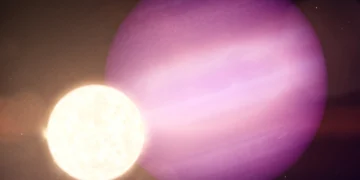The search for exoplanets has always been a journey filled with wonder, surprises, and the thrill of the unknown. Now, the James Webb Space Telescope (JWST) has added a major milestone to that journey: the confirmation of the coldest exoplanet ever discovered, orbiting a white dwarf star 81 light-years from Earth. This breakthrough isn’t just about breaking records; it’s about reshaping our understanding of how planets survive the most violent endings of stars.
A Giant Discovery Around a Dying Star
Discovering a giant planet orbiting a stellar corpse is nothing short of astonishing. WD 1856+534 b orbits a white dwarf — the dense, dim remnant left behind after a Sun-like star exhausts its nuclear fuel and collapses. Such an environment should be hostile to planets, destroying or ejecting them during the star’s death throes.
Yet, against all odds, WD 1856+534 b remains. Detected first in 2020 and now confirmed with the JWST, this planet provides irrefutable evidence that planetary systems can survive even the catastrophic end of their parent stars. It sits in a tight orbit, completing a full revolution around its white dwarf host in just 34 hours. This resilience challenges previous assumptions about how destructive the late stages of stellar evolution really are.
Understanding how WD 1856+534 b survived — and even migrated closer to its host — reshapes our predictions for the future of planetary systems, including our own.
How Webb Made the Impossible, Possible
Directly imaging planets is one of astronomy’s greatest challenges because planets are faint compared to the stars they orbit. But this time, the odds shifted. White dwarfs are dimmer than normal stars, giving telescopes like Webb a rare advantage.
The Mid-Infrared Instrument (MIRI) on JWST allowed astronomers to block the dim starlight and isolate the faint infrared glow of WD 1856+534 b. Rather than being overwhelmed by brightness, they could clearly detect the planet’s own thermal radiation — a first for a planet this cold.
This was a perfect match of method and object: a cold planet around a faint star, observed by a telescope built specifically to detect the faintest infrared signals. It’s a triumph for technology, opening a new path for finding colder, smaller worlds that might have remained invisible to older generations of telescopes.
Thanks to JWST’s capabilities, studying exoplanets around white dwarfs is no longer a dream — it’s now a reality.
Why WD 1856+534 b Is Special: Survival Against All Odds
The survival story of WD 1856+534 b is incredible. When a star like our Sun nears the end of its life, it swells into a red giant, engulfing nearby planets and rearranging the orbits of anything that survives. Eventually, it sheds its outer layers and shrinks into a white dwarf, leaving behind a turbulent graveyard of debris.
For a planet like WD 1856+534 b to still exist, so close to its white dwarf, is a cosmic miracle. Previous models suggested that planets this close would either be consumed or ejected. Yet JWST’s precision measurements showed that this gas giant not only survived but migrated inward after the chaos, settling into a stable, close orbit.
This migration hints at complex gravitational interactions, possibly involving other planets or remnants that nudged WD 1856+534 b inward over millions of years. It’s a living example that destruction is not the only fate for planetary systems after a star’s death. Survival, against the odds, is a very real possibility.
Studying planets like WD 1856+534 b helps scientists predict what might happen to our own Solar System when the Sun eventually dies.
The Science Behind a Frozen Giant
WD 1856+534 b is a frosty wonder, setting a new benchmark in the study of cold planetary atmospheres. With an average atmospheric temperature of about -87°C (-125°F), this world is colder than any exoplanet whose emission has ever been directly detected.
Before this discovery, no exoplanet colder than 275 Kelvin had ever been imaged directly. Breaking that barrier is more than just a scientific trophy; it gives researchers a rare laboratory for studying the chemistry and behavior of cold, massive atmospheres.
Cold gas giants like WD 1856+534 b may share similarities with objects in the outer reaches of our Solar System, like Neptune or Uranus, but they offer a window into different planetary histories and migrations. Their atmospheres, formed under extreme conditions, can reveal insights into how planets form, move, and survive even in the most inhospitable cosmic neighborhoods.
This planet proves that the Universe still holds many secrets in the cold and the dark — we just need the right tools to find them.
What Comes Next: The Future of White Dwarf Worlds
The story of WD 1856+534 b is only beginning. Scheduled JWST observations for 2025 will use even more sensitive instruments like the Near-Infrared Spectrometer (NIRSpec) to probe deeper into the planet’s atmosphere. Scientists hope to uncover what molecules exist there — and perhaps even hint at processes that could support life in extreme conditions.
There’s also the intriguing possibility that WD 1856+534 b isn’t alone. The planet’s migration inward may have been triggered by the gravitational push of unseen companions. Further studies could reveal additional planets orbiting the white dwarf, giving astronomers a chance to understand how whole planetary systems can endure death and rebirth.
Understanding these worlds not only expands the scope of exoplanetary science but also informs the future of humanity’s search for life beyond Earth. Could dying stars still host life-bearing planets? Discoveries like WD 1856+534 b bring that dream one step closer to reality.
Conclusion: A New Frontier for Cosmic Exploration
The confirmation of WD 1856+534 b as the coldest known exoplanet orbiting a white dwarf is a stunning leap forward in our exploration of the Universe. This lonely, frozen giant, orbiting the faint ember of a once-brilliant star, is a powerful symbol of resilience in the cosmos.
Reference:
Thermal Emission and Confirmation of the Frigid White Dwarf Exoplanet WD 1856+534 b



















